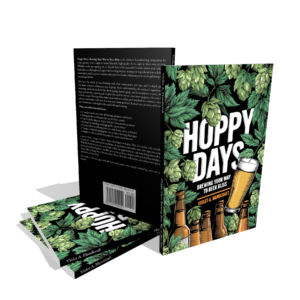Complete Guide to Homebrewing – Hoppy Days: Master Beer Brewing Techniques From Beginner to Expert

Transform your kitchen into a craft brewery with the ultimate homebrewing guide that makes beer brewing accessible for everyone. If you’ve ever dreamed of creating your own signature beers but felt overwhelmed by complex brewing processes, “Hoppy Days: Brewing Your Way to Beer Bliss” provides the perfect solution. This comprehensive beer brewing guide eliminates the guesswork from homebrewing, offering step-by-step techniques that take you from complete beginner to confident craft beer maker. Unlike generic brewing manuals that focus only on theory, this book emphasizes practical application with real-world brewing techniques you can implement immediately in your own kitchen.
Whether you’re interested in mastering traditional brewing methods or experimenting with innovative flavor combinations, this homebrew guide provides everything needed to create exceptional craft beer at home. The author’s approach combines time-tested brewing fundamentals with creative experimentation, ensuring you develop both technical skills and brewing creativity that sets your beers apart from commercial alternatives.
What You’ll Discover
- Master Essential Brewing Techniques: Learn step-by-step mashing, boiling, and fermentation processes that form the foundation of professional-quality homebrewing
- Create Custom Beer Recipes: Discover how to design unique homebrew recipes from scratch, tailoring every ingredient to match your personal taste preferences
- Advanced Flavor Infusion Methods: Master creative techniques for enhancing your beer with fruits, spices, herbs, and unconventional ingredients for distinctive flavor profiles
- Troubleshoot Common Brewing Challenges: Overcome typical homebrewing obstacles with practical solutions that ensure consistent, high-quality results every batch
- Equipment Mastery and Optimization: Learn to maximize your brewing setup, from basic starter equipment to advanced techniques for temperature and timing control
- Transform Raw Ingredients into Craft Beer Excellence: Develop the skills to manipulate fermentation conditions and ingredient combinations for complex, professional-quality beers
Why This Book Matters
Homebrewing represents more than just a hobby—it’s an art form that combines science, creativity, and personal expression in every batch. This comprehensive brewing guide addresses the main challenges that prevent aspiring brewers from achieving consistent success: lack of proper technique understanding, insufficient troubleshooting knowledge, and limited creative inspiration. With expert insights into temperature control, ingredient selection, and fermentation optimization, you’ll develop the confidence to experiment boldly while maintaining technical precision.
The book’s practical approach ensures immediate application of brewing techniques, eliminating the trial-and-error period that frustrates many beginning homebrewers. You’ll gain professional-level knowledge about hop utilization, grain bill formulation, and yeast management that typically takes years to develop through experimentation alone.
Key Features
This comprehensive ebook spans multiple chapters covering everything from basic equipment setup to advanced brewing techniques and custom recipe development. Available as an instant digital download, you’ll receive immediate access to detailed brewing guides, troubleshooting charts, and recipe formulation worksheets. The format allows for easy reading on any device, with printable reference guides for hands-on practice during brewing sessions. Also available as audiobook on Google Play Books and Spotify for convenient listening during commutes, workouts, or while actually brewing your beer.
Frequently Asked Questions
Can complete beginners successfully brew beer using this homebrewing guide?
Absolutely! This book specifically addresses beginners with clear, step-by-step instructions for every brewing technique. The author breaks down complex processes like mashing and fermentation into manageable steps, providing troubleshooting guidance that prevents common mistakes. Even with zero brewing experience, you’ll have the knowledge needed to create quality beer from your first batch.
What makes this beer brewing book different from free online brewing resources?
Unlike scattered online information, this comprehensive guide provides a structured learning path from basic techniques to advanced brewing creativity. You’ll get proven recipes, professional troubleshooting methods, and ingredient optimization strategies that typically require years of experimentation to discover independently. The systematic approach ensures consistent results rather than hit-or-miss brewing attempts.
Do I need expensive equipment to implement these homebrewing techniques successfully?
The book covers brewing with basic equipment that most beginners can afford, focusing on technique mastery rather than expensive gear. You’ll learn to achieve professional results using standard homebrewing supplies, with guidance on equipment optimization and upgrades as your brewing skills develop. Quality brewing depends more on proper technique than costly equipment.
Get Your Copy Today
Transform your homebrewing journey with this comprehensive guide to craft beer creation. Available for instant download at just $6.99, this ebook provides exceptional value compared to expensive brewing courses or workshops that can cost hundreds of dollars. Also available as audiobook on Google Play Books and Spotify for convenient learning during any activity. Purchase your copy through all major ebook retailers including Apple Books, Barnes & Noble, and Kobo to begin mastering professional brewing techniques and creating your signature craft beers today.
Watch the Video Review

